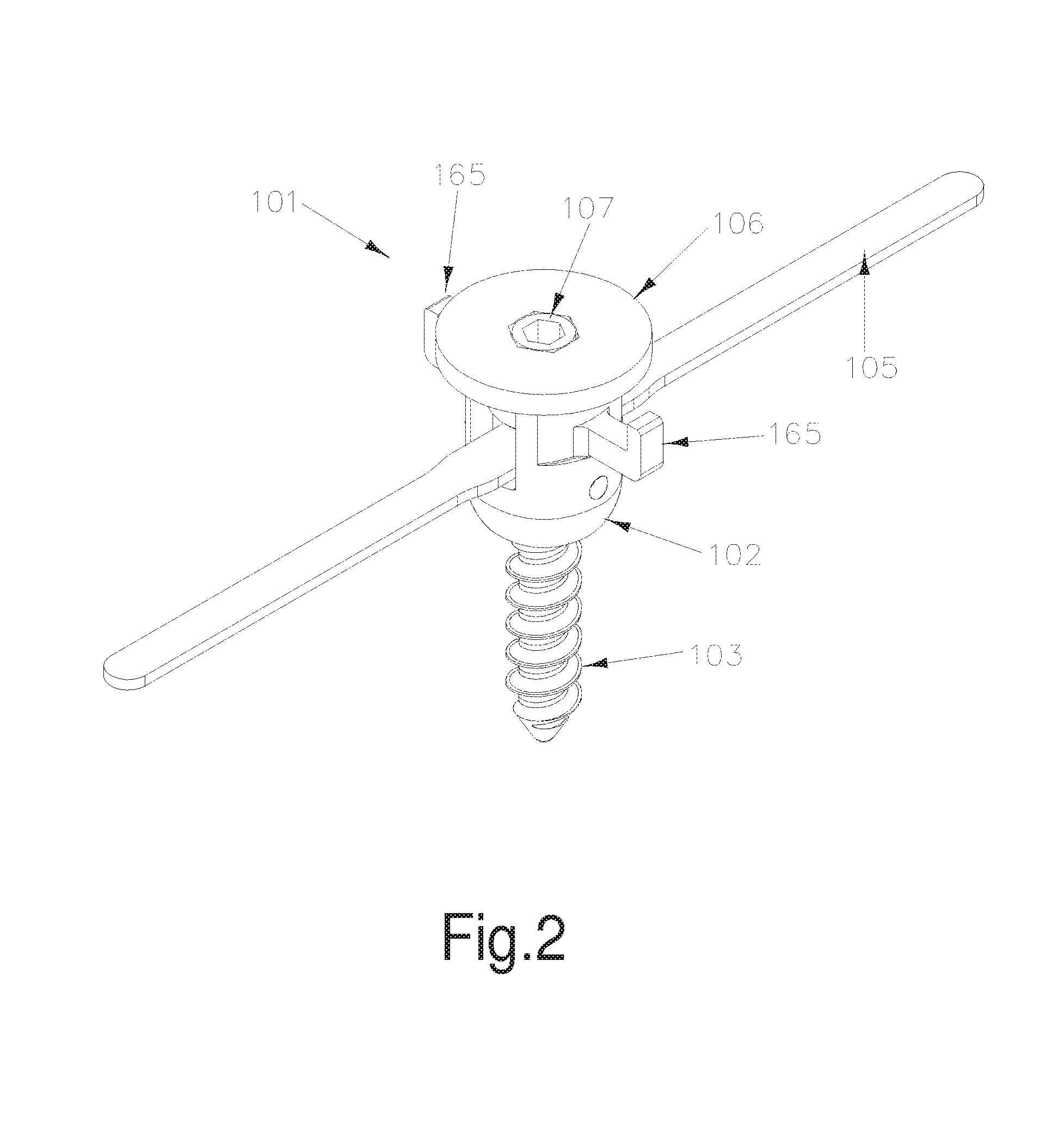Method and apparatus for the treatment of scoliosis
a technology for scoliosis and treatment methods, applied in the field of scoliosis treatment methods, can solve the problems of insufficient kyphosis in the central part of the spine, inability to fully correct a three-dimensional deformity, and inability to allow the patient to retain a full range of motion
- Summary
- Abstract
- Description
- Claims
- Application Information
AI Technical Summary
Benefits of technology
Problems solved by technology
Method used
Image
Examples
first preferred embodiment
[0079]FIGS. 1, 2 and 3 show a first preferred embodiment of an implant module 101 which is part of the apparatus of the present invention.
[0080]The implant module 101 includes a cage 102, a pedicle screw 103, a spring socket 104, spring 105, spring cap 106 and tensioner 107. Each part of the implant module is made of biologically inert, sterilisable materials suitable for implantation in a live host.
[0081]Pedicle screw 103 is similar to a well-known type including a screw threaded column 130 adapted to engage with a pedicle of a vertebra. At a first end of column 130, a rounded screw head 160 is provided with tool engagement means, preferably in the form of a screw tool cavity 132 adapted to receive a tool, e.g. an Allen key. Engagement of an appropriate known type of tool with these tool engagement means will allow rotation of the screw 103, and therefore engagement of column 130 with a pedicle.
[0082]Screw 103 may be similar to any of the many different commercially available spina...
second preferred embodiment
[0104]FIG. 5 and FIG. 6 show two different views of a second embodiment of an implant module 201 which is a part of the apparatus of the present invention.
[0105]The implant module 201 includes a pedicle screw 203, similar to a well known type including a screw threaded column 230 adapted to engage with a pedicle of a vertebra. The column 230 is co-axial with a screw-threaded shaft 233. To allow for screwing the screw 203 into a pedicle, tool engagement means may be provided on or adjacent the shaft 233. These tool engagement means may include external flats 231 and / or a screw tool cavity 232 adapted to receive a tool, e.g. an Allen key. Engagement of an appropriate known type of tool with either of these tool engagement means will allow rotation of the screw 203, and therefore engagement of column 230 with a pedicle.
[0106]Screw 203 may be similar to any of the many different commercially available spinal screws. In alternative embodiments, the pedicle screws 203 may be replaced with...
third embodiment
[0124]FIG. 7 and FIG. 8 show two different views of a third embodiment of an implant module 301 which is a part of the apparatus of the present invention.
[0125]The implant module 301 includes a cage 302, a pedicle screw 303, a spring socket 304, spring 305, and connection means 307. Pedicle screw 303 includes a screw threaded column 330 adapted to engage with a pedicle of a vertebra. At a first end of column 330, a rounded screw head 360 is provided with tool engagement means, preferably in the form of a screw tool cavity 332 adapted to receive a tool, e.g. an Allen key.
[0126]Cage 302 has an essentially cylindrical cage body 361, with a central bore 362 dimensioned such that screw threaded column 330 of pedicle screw 303 passes therethrough and the screw threaded column 330 extends from a first end of the cage body 361, but the rounded screw head 360 is retained within the bore 362 of the cylindrical cage body 361.
[0127]The sidewall of the cage body 361 includes two cage spring slot...
PUM
 Login to View More
Login to View More Abstract
Description
Claims
Application Information
 Login to View More
Login to View More - R&D
- Intellectual Property
- Life Sciences
- Materials
- Tech Scout
- Unparalleled Data Quality
- Higher Quality Content
- 60% Fewer Hallucinations
Browse by: Latest US Patents, China's latest patents, Technical Efficacy Thesaurus, Application Domain, Technology Topic, Popular Technical Reports.
© 2025 PatSnap. All rights reserved.Legal|Privacy policy|Modern Slavery Act Transparency Statement|Sitemap|About US| Contact US: help@patsnap.com



